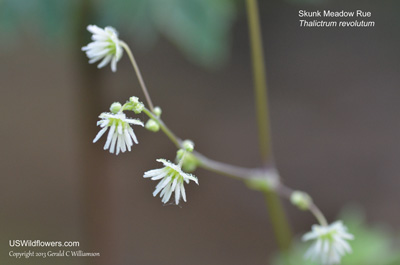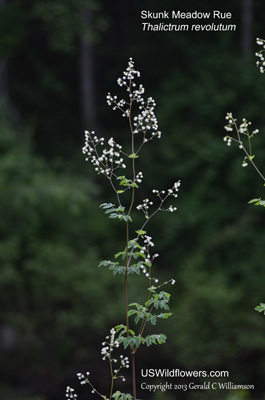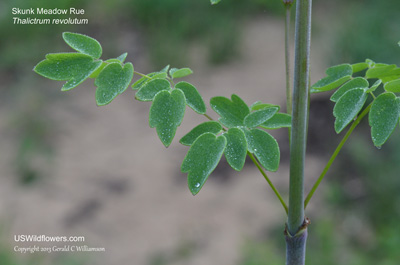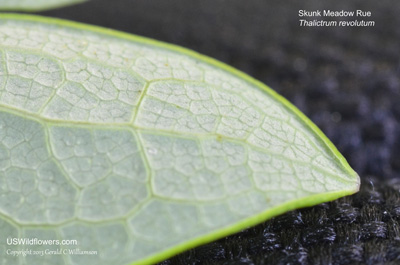Skunk Meadow Rue, Waxyleaf Meadowrue, Purple Meadow-rue - Thalictrum revolutum
|
Thalictrum revolutum - Skunk Meadow Rue, Waxyleaf Meadowrue, Purple Meadow-rue. A wind pollinated, dioecious plant of late spring to mid-summer. As with all Thalictrum species, T. revolutum does not have petals, but rather inconspicuous sepals. It gets its Skunk Meadow Rue common name from the odor of the crushed vegetation. This plant is found in a large swath of the United States except for a number of states in the northwestern quadrant. It is also found in much of eastern Canada. It is Endangered in Iowa and "Historical" in Rhode Island.
The common name "Purple Meadow-rue" is also shared with Thalictrum dasycarpum, or perhaps that Rhode Island listing is a result of a mistaken identification, since there is some confusion among the species in the genus.
Found in:
AL, AR, AZ, CO, CT, DC, DE, FL, GA, IA, IL, IN, KY, LA, MA, MD, MI, MN, MO, MS, NC, NH, NJ, NM, NV, NY, OH, OK, PA, RI, SC, SD, TN, TX, VA, WI, WV
Leave comments on Thalictrum revolutum at this link. | 
Distribution of Thalictrum revolutum in the United States and Canada:

Blue=Native; Grey=Introduced
Map from USDA Plants Database:
USDA, NRCS. 2017. The PLANTS Database (http://plants.usda.gov, 08 May 2025). National Plant Data Team, Greensboro, NC 27401-4901 USA.
Search Our Database: Enter any portion of the Scientific, Common Name, or both.
Do a general Google search of the entire site:
#ad
 Follow USWildflowers on Twitter
#ad
| | Site: Nickajack Road, Walker County, GA Date: 2013-June-07 | Photographer: Gerald C. Williamson
Nikon D7000
Tamron SP 90MM f/2.8 AF Macro | | The staminate (male) flower has 4 to 6 sepals that often drop off at flowering, leaving about a dozen drooping stamens per flower. The inflorescence has many flowers, and there is usually multiple inflorescences on each plant. Being dioecious, a particular plant will have only male or female flowers, not both. | | 
| | Site: Nickajack Road, Walker County, GA Date: 2013-June-07 | Photographer: Gerald C Williamson
Nikon D7000
Tamron SP 90MM f/2.8 AF Macro | | While the pistillate (female) flowers may be held downward, they can also be held erect, and do not have the drooping appearance of the male, staminate flowers. Being dioecious, a particular plant will have only male or female flowers, not both. | | Click on the photo for a larger image

| | Site: Nickajack Road, Walker County, GA Date: 2013-June-07 | Photographer: Gerald C Williamson
Nikon D7000 | | Skunk Meadow Rue is a tall plant - it can be over 7 feet tall - and branches occasionally in the upper part of the plant with an inflorescence terminating each branch. | | Click on the photo for a larger image

| | Site: Nickajack Road, Walker County, GA Date: 2013-June-07 | Photographer: Gerald C Williamson
Nikon D7000
Tamron SP 90MM f/2.8 AF Macro | | Glaucous stems are green, turning to reddish purple as it ages. Smaller leaflets unlobed, while most leaflets will have 2 or more commonly 3 lobes, and are generally less than 2 inches across in both dimensions. The leaves can be up to 4 times ternately compound. | | Click on the photo for a larger image

| | Site: Nickajack Road, Walker County, GA Date: 2013-June-15 | Photographer: Gerald C Williamson
Nikon D7000 | | This photo shows the waxy-looking underside of the leaf of Thalictrum revolutum, from whence comes the Waxyleaf Meadowrue common name. It also shows the feature from whence comes the "revolutum" species epithet. Note the margin of the leaf is "revolute" - it is rolled back underneath the leaf. Without a magnifying glass (or a photographic enlargement) it appears to be just a green margin underneath the leaf, but in this photo at the leaf tip you can detect the shadow showing that rolled-back edge. | | Click on the photo for a larger image

|
References used for identification and information:
|
|
| |
| #ad
|
|







